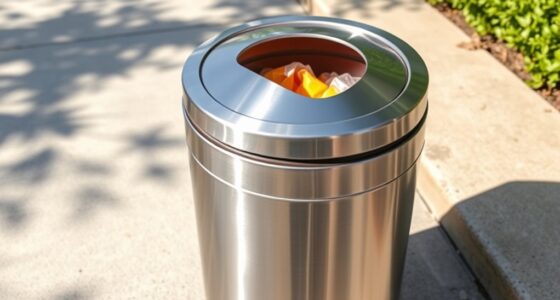To eliminate skunk smell safely, I recommend using a mixture of hydrogen peroxide, baking soda, and dish soap, which effectively neutralizes the odor without harsh chemicals. I carefully apply the solution to skin, clothing, or furniture, letting it sit for about five minutes before rinsing. For persistent smells, adding activated charcoal can help absorb lingering odors. If you want to learn the exact steps and precautions, keep going to discover more effective techniques that protect you and your space.
Key Takeaways
- Use a hydrogen peroxide, baking soda, and dish soap mixture to chemically neutralize skunk odor.
- Apply the solution thoroughly, let it sit for five minutes, then rinse or wipe away residues.
- Avoid using harsh chemicals on delicate fabrics or painted surfaces to prevent damage.
- For persistent smells, utilize activated charcoal to absorb lingering odors over time.
- Repeat treatments if necessary, especially on porous materials, to fully eliminate the skunk smell safely.

Skunk smell can be overwhelming and stubborn to remove, but I’ve found effective methods to eliminate it quickly. The key lies in understanding skunk spray chemistry. Skunk spray contains thiols and thioacetates—compounds that create that intense, pungent odor. These chemicals are remarkably resilient, which is why standard cleaning often fails. To combat this, I rely on household odor absorbers that react with these compounds to neutralize the smell rather than just mask it.
One of my go-to solutions is a mixture of hydrogen peroxide, baking soda, and dish soap. The hydrogen peroxide acts as a powerful oxidizer, breaking down the thiols into odorless compounds. Baking soda absorbs any residual odor and helps lift the smell from surfaces or fur. Dish soap cuts through oils and helps the solution spread evenly, ensuring the chemicals react fully. I always wear gloves and avoid using this mixture on delicate fabrics or painted surfaces, as it can cause discoloration.
For quick application, I combine a cup of hydrogen peroxide, a quarter cup of baking soda, and a teaspoon of dish soap in a bucket or spray bottle. If I’m dealing with a pet or fur, I dilute it slightly to prevent irritation. I apply the solution liberally, scrubbing or spraying until the area is thoroughly coated. Once it sits for about five minutes, I rinse or wipe the area clean. This method is surprisingly effective at neutralizing the skunk spray’s chemical bonds, often within a few minutes.
If the smell persists on fabric or upholstery, I turn to household odor absorbers like activated charcoal or commercial odor neutralizers. Activated charcoal is especially good at trapping odor molecules, so I leave it in open containers near the affected area for a few hours or overnight. For clothing or bedding, washing with a strong detergent, preferably with added baking soda or vinegar, helps further eliminate the smell. Using earplugs for concerts can also help protect your hearing if you’re sensitive to strong odors lingering in enclosed spaces.
In my experience, patience is essential. Sometimes, a second treatment is necessary, especially if the skunk spray has soaked deep into porous materials. But understanding skunk spray chemistry and using household odor absorbers makes the process manageable. It’s all about neutralizing those powerful thiols chemically, rather than just masking the smell with air fresheners. With these methods, I’ve managed to restore my space and my pets’ comfort quickly and safely.
Frequently Asked Questions
Can I Use Homemade Remedies to Remove Skunk Odor?
Yes, I use homemade solutions and natural remedies to remove skunk odor effectively. I mix hydrogen peroxide, baking soda, and dish soap, which works wonders at neutralizing the smell. These natural remedies are safe and inexpensive, making them my go-to DIY solution. Just remember to wear gloves and avoid storing the mixture in airtight containers, and always test on a small area first to prevent damage.
How Long Does It Take for the Smell to Fully Disappear?
The skunk odor can take anywhere from a few days to a couple of weeks to fully disappear, depending on the severity of the smell and how quickly you treat it. I’ve found that consistent cleaning and airing out the affected area help reduce the smell duration. Patience is key, but with the right approach, the skunk odor will gradually fade, and you’ll notice a significant difference over time.
Is It Safe to Use Commercial Deodorizers Indoors?
I wouldn’t recommend using commercial deodorizers indoors without checking their chemical safety first. They might seem effective, but many contain strong chemicals that could affect indoor air quality negatively, especially if you have kids or pets. Instead, opt for natural odor absorbers like baking soda or white vinegar. These are safer options that won’t compromise your home’s air quality or pose health risks.
Should I Wear Protective Gear When Cleaning Skunk Spray?
Yes, I always wear protective clothing and a respirator mask when cleaning skunk spray. It’s essential to safeguard my skin from the strong odor and harmful oils, and the mask prevents me from inhaling any irritating fumes. Skunk spray contains chemicals that can cause respiratory issues, so I never skip this gear. Staying safe while cleaning ensures I avoid health problems and can effectively eliminate the smell.
Can Pets Recover From Skunk Spray Exposure?
Pets can recover from skunk spray effects, but it depends on the severity of exposure and how quickly you act. I’ve seen pets bounce back with prompt, thorough cleaning and proper care. It’s vital to wash their face, fur, and paws thoroughly, and sometimes vet visits are necessary for eye or respiratory issues. With patience and proper treatment, your pet can recover and return to normal.
Conclusion
After trying various remedies, I found that a mixture of hydrogen peroxide, baking soda, and dish soap really works. I also read that this combination breaks down the skunk oil molecules effectively, which makes sense because peroxide is a strong oxidizer. Just remember to wear gloves and avoid breathing in the fumes. With patience and the right solution, you’ll get rid of that stubborn smell safely and quickly—trust me, it’s worth the effort!









